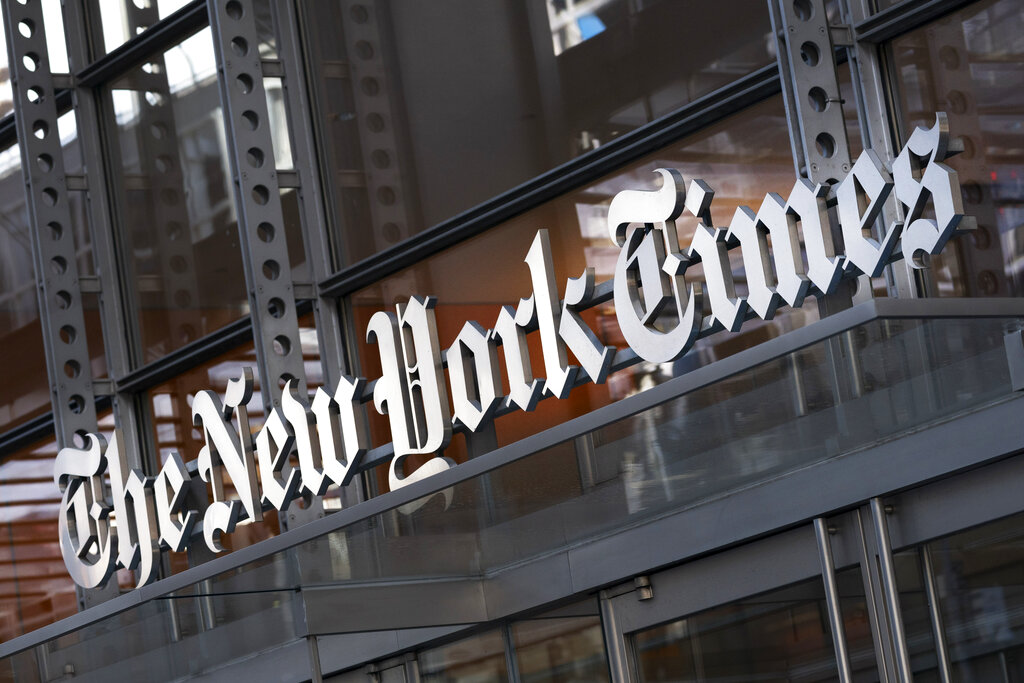Sarah Palin Prepares for Final Showdown With New York Times in Defamation Case: Will She Settle, or Stand Her Ground?
The Alaskan could upend libel law — and the Gray Lady tells the Sun that it expects trial will go ‘ahead as scheduled.’

The third time could be the charm for Governor Palin’s defamation retrial against the New York Times, now scheduled for April 14 — unless both the Alaskan and the Gray Lady settle outside of court. Comments from attorneys for both sides and from the judge in the longrunning case suggest a settlement is very much in the cards.
The stakes of Ms. Palin’s case against the Gray Lady have only grown as tensions escalate between President Trump and the press. Meanwhile, the Supreme Court precedent that governs defamation law — New York Times v. Sullivan, decided by a unanimous court in 1964 — could be ripe for revisiting.
Ms. Palin is suing the New York Times which it issued in 2017 and which inaccurately linked her rhetoric in 2008 to the 2011 shooting in Arizona that killed six people and gravely wounded Congresswoman Gabby Giffords. The Times published a correction below the editorial, which continues to name Ms. Palin, and has vigorously defended itself in the suit during its convoluted journey through the legal system.
With the political climate toward the press evolving, though, the case may ultimately be resolved with a settlement. During a hearing in November a lawyer for the Times, David Axelrod, mused that “It may be that we don’t need a trial at all.” The presiding judge, Jed Rakoff of the Southern District of New York, reckoned that “I’m all for that if you’re seriously interested in settling. You can settle it in a matter of days.”
A New York Times spokesman tells the Sun that the “trial is scheduled to begin on April 14 and we anticipate it will go ahead as scheduled.” The docket has been largely silent since November, with just one bookkeeping entry logged last month.
That quiet could suggest that the sides are engaged in private talks directed at a settlement, or that they have retreated to their corners to prepare for another round of bruising litigation. ABC News in November settled a defamation suit with Mr. Trump for $15 million and CNN also recently settled a defamation lawsuit from a military veteran for an undisclosed amount. CBS News is reportedly considering a similar arrangement.
Those lawsuits were filed in Southern states, where largely conservative judges and juries could be seen as more sympathetic to critiques of the press. In contrast, Ms. Palin’s case is in a New York courtroom and Judge Rakoff, despite a maverick streak, is considered a jurist of the left. The judge is a familiar face to both parties. He has handled the case from the beginning, when in 2017 Ms. Palin sued the Times, her longtime detractor, over the incorrect editorial linking her to murders.

The Times acknowledged that the editorial was inaccurate, but claimed that it amounted to an “honest mistake.” Ms. Palin, though, insists that the Times met the Sullivan standard for defamation of public figures — “actual malice.” That is a high bar which requires showing that a defendant published a defamatory statement with “with knowledge that it was false or with reckless disregard of whether it was false or not.”
The first libel case in 18 years to go to trial against the Times has taken a circuitous path through the federal judiciary. Judge Rakoff first dismissed it months after it was docketed, reasoning that Ms. Palin failed to show actual malice. The Second United States Appeals Circuit reinstated the suit after ruling that Judge Rakoff mishandled an evidentiary hearing.
Judge Rakoff in August of 2020 denied requests of both parties for summary judgment. That precipitated a second trial, where a jury unanimously found for the Times. A day before the verdict was brought in, though, Judge Rakoff announced in open court that he intended to find for the newspaper anyway on the basis of the evidence adduced at trial. Some jurors received notification of that decision via push notifications on their telephones.
The circuit riders of the Second United States Appeals Circuit found that Judge Rakoffa’s ruling while the jury was deliberating “improperly intruded on the province of the jury by making credibility determinations, weighing evidence, and ignoring facts or inferences that a reasonable juror could plausibly have found to support Palin’s case.”
While Ms. Palin did not initially argue that Sullivan ought to be overturned, on her appeal to the Second Circuit she contended that “the actual malice standard is either no longer good law or should not apply to her case.” The circuit riders, while they granted her request for a new trial, rebuffed her effort to force a reconsideration of Sullivan.
The appellate tribunal reasoned that the “law of the case” doctrine applied, meaning that Ms. Palin could have challenged Sullivan only at an earlier stage of the case. Still, a third faceoff between Ms. Palin and the Times could amount to something of a referendum on Sullivan at a moment when two justices have expressed an interest in overturning the powerful precedent.
One of those is Justice Clarence Thomas, who has written that Sullivan and its progeny “were policy-driven decisions masquerading as constitutional law” with “no relation to the text, history or structure of the Constitution.”
Justice Thomas is joined in his antipathy to the Sullivan standard by Justice Neil Gorsuch, who has ventured that “What started in 1964 with a decision to tolerate the occasional falsehood to ensure robust reporting by a comparative handful of print and broadcast outlets has evolved into an ironclad subsidy for the publication of falsehoods by means and on a scale previously unimaginable.”
Whether Justices Thomas and Gorsuch can recruit another three justices to their cause is in doubt, especially as Sullivan continues to be cited as authoritative Supreme Court precedent. The two skeptics of Sullivan, though, can count on a powerful ally — Mr. Trump. In a court filing from a 2022 suit against CNN for defamation, his lawyers likened the Sullivan standard to a “subsidy for published falsehoods on a scale no one could have foreseen.”
Six years earlier, during Mr. Trump’s successful campaign for president, he vowed to “open up our libel laws, so when they write purposely negative and horrible and false articles, we can sue them and win lots of money. So we’re going to open up those libel laws, folks, and we’re going to have people sue you like you’ve never got sued before.”
Counsel for Ms. Palin did not respond to a request for comment by the time this article went to print.

